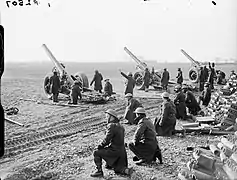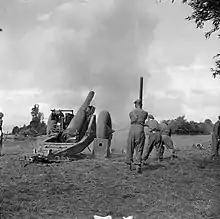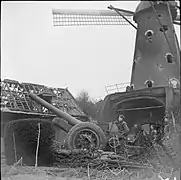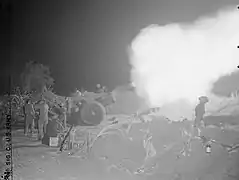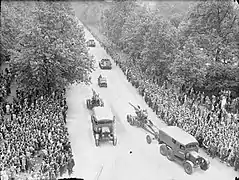BL 7.2-inch howitzer
The BL 7.2-inch howitzer was a heavy artillery piece used by the British Army throughout the Second World War.
| BL 7.2-inch howitzer Mk I-IV | |
|---|---|
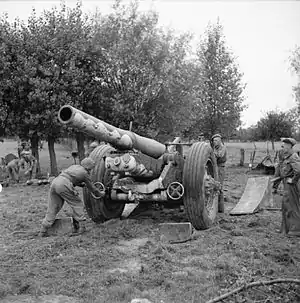 7.2-inch howitzer of 51st Heavy Regiment, Royal Artillery. France, September 1944. | |
| Type | Howitzer |
| Place of origin | United Kingdom |
| Service history | |
| In service | 1940–1944 |
| Wars | Second World War |
| Production history | |
| Designed | 1940 |
| Produced | 1940–1944 |
| Variants | Mk I, Mk II, Mk III & Mk IV |
| Specifications | |
| Mass | 10.22 long tons (10.38 t) |
| Length | 24 ft 4 in (7.42 m) |
| Barrel length | 14 ft 3 in (4.34 m) L/22.4 |
| Width | 9 ft (2.7 m) |
| Height | 4 ft 3 in (1.30 m) |
| Crew | 10 |
| Shell | HE |
| Shell weight | 202 pounds (92 kg) |
| Calibre | 7.2 inches (182.9 mm) |
| Breech | Welin screw & asbury mech |
| Carriage | Box trail |
| Elevation | 0° to 45° |
| Traverse | 4° left & right |
| Rate of fire | 3 rpm under optimal conditions |
| Muzzle velocity | 1,697 ft/s (517 m/s) |
| Maximum firing range | 16,900 yd (15,500 m) |
| References | Chris Bishop[1][2] & Nigel Evans[3] |
| BL 7.2-inch howitzer Mk 6 | |
|---|---|
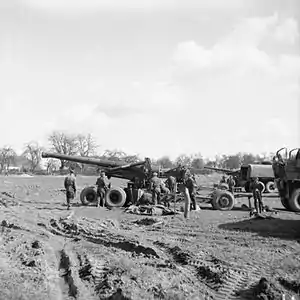 7.2 in howitzer Mk 6, on the US M1 carriage. Rhine crossing, 1945. | |
| Service history | |
| In service | 1944–early 1960s |
| Wars | Second World War |
| Production history | |
| Designed | 1944 |
| Produced | 1944–1945 |
| Specifications | |
| Mass | Traveling 17.5 long tons (17.8 t) in action 13 long tons (13 t) |
| Length | 34 ft (10 m) |
| Barrel length | 20 ft 8 in (6.30 m) L/33.1 |
| Width | 8 ft (2.4 m) |
| Height | 8 ft 3 in (2.51 m) |
| Crew | 12 |
| Carriage | Split trail |
| Elevation | -1° to 63° |
| Traverse | 30° left & right |
| Muzzle velocity | 1,925 ft/s (587 m/s) |
| Maximum firing range | 19,667 yd (17,984 m) |
| References | Chris Bishop[1][2] & Nigel Evans[3] |
History
In 1940 the British Army concluded that the only heavy howitzer available to it, the First World War-era BL 8-inch howitzer, had insufficient range for the conditions of Second World War. As a stopgap the decision was made to re-line the existing barrels to a smaller calibre and develop a new range of ammunition to achieve the desired ranges.[1][2][4]
Marks I–IV
The 8-inch barrels were re-lined to 7.2 inches (183 mm) and the old carriages were retained although the original steel rimmed wheels were replaced with new pneumatic balloon-tyre wheels, as was consistent with the motorisation of the British Army. The new four-charge ammunition increased the range to 16,900 yd (15,500 m), but when fired at full charge the recoil caused the weapon to rear violently and jump backwards. To help counter this, two wedge shaped ramps were placed behind the wheels although the gun could sometimes still jump over them, presenting a hazard to crews. Marks I–IV differed only in the original 8-inch barrel used and the type of conversion; some barrels and carriages were also supplied from US First World War stocks.[1][2][5]
Mark V
In 1944 several 7.2-inch barrels were placed in the US Carriage M1 used by the 155 mm Long Tom already in use by the British Army, becoming the BL 7.2-inch howitzer Mk V. Few Mk Vs were produced and it was never issued to batteries, as it was apparent that the Carriage M1 was capable of accepting greater recoil forces.[1][2]
Mark 6
The BL 7.2-inch howitzer Mk 6 (there was a shift from Roman numerals) retained the Carriage M1 of the Mk V but had a new built 7.2-inch 6 ft 5 in (1.96 m) longer barrel than previous marks, additionally a fifth charge was added to the ammunition. The longer barrel and extra charge provided a range increase to 19,667 yd (17,984 m), the new carriage also provided a far more stable platform, greatly increasing accuracy. The Mk 6 was considered a highly effective gun and it was retained in service after the war.[1][2]
Use
The original marks performed well. The first 7.2-inch howitzers were issued to batteries from mid-1942 and used in action in North Africa and later following the Normandy landings. In Burma they were provided as a pool of two guns per corps and used by Regiments as required. By the end of 1944, most of the earlier marks had been replaced by the Mk 6.[1][2]
The usual gun tractor for the 7.2-inch howitzer in the early war years was the Scammell Pioneer, although this was never available in sufficient numbers and from late 1943 the Pioneer was supplemented by the Albion CX22S.[6]
The BL 7.2-inch howitzer was usually employed in two four-gun batteries (alongside two four-gun batteries equipped with the 155mm Long Tom) of "Heavy" regiments of Army Group Royal Artillery (AGRA) units, providing heavy fire support for British and Commonwealth troops. The Mk 6 remained in British Army service until the early 1960s.[2][3][7]
User units
- 57 (later 166) (Newfoundland) Field Artillery Regiment
- 59 (Newfoundland) Heavy Regiment
- 1 Heavy Regiment
- 32 Heavy Regiment
- 51 (Lowland) Heavy Regiment – North West Europe Campaign
- 52 (Bedfordshire Yeomanry) Heavy Regiment – North West Europe Campaign
- 53 Heavy Regiment
- 54 Heavy Regiment
- 55 Heavy Regiment
- 56 Heavy Regiment – Mediterranean Theatre and North West Europe Campaign
- 58 Heavy Regiment
- 60 Heavy Regiment
- 61 Heavy Regiment
- 75 Heavy Regiment
- 171 Heavy Regiment
- 114th (Sussex) Field Regiment – 2 gun section during Burma Campaign
- 8th (Belfast) Heavy Anti-Aircraft Regiment – 2 gun section during Burma Campaign
- 52nd (London) Heavy Anti-Aircraft Regiment – 2 gun section during Burma Campaign
- 56th (Cornwall) Heavy Anti-Aircraft Regiment – 2 gun section during Burma Campaign
- 67th (York and Lancaster Regiment) Heavy Anti-Aircraft Regiment – 2 gun section during Burma Campaign
- 101st Heavy Anti-Aircraft Regiment – 2 gun section during Burma Campaign
Gallery
See also
| Wikimedia Commons has media related to BL 7.2 inch Howitzer. |
- List of howitzers
- 8 inch Howitzer M1 – US equivalent, sharing the Carriage M1
- 203 mm howitzer M1931 (B-4) – approximate Soviet equivalent
References
- Chris Bishop (ed), The encyclopedia of small arms and artillery, Koo nr Rochester: Grange Books, 2006, ISBN 978-1-84013-910-5.
- Chris Bishop (ed), The encyclopedia of weapons of World War II, London: Metro Books, 1998, ISBN 1-58663-762-2.
- Nigel F Evans, "7.2-inch howitzer", nigelef.tripod.com, retrieved 26 June 2018.
- Gen Sir Martin Farndale, History of the Royal Regiment of Artillery: the years of defeat, Europe and North Africa 1939–1941, London: Brasseys, 1996, ISBN 1-85753-080-2.
- Williford, Glen M. (2016). American Breechloading Mobile Artillery, 1875-1953. Atglen, Pennsylvania: Schiffer Publishing. pp. 108–111. ISBN 978-0-7643-5049-8.
- Pat Ware, A complete directory of military vehicles, Wigston: Anness Publishing Ltd, 2012.
- Nigel F Evans, "Organisations", nigelef.tripod.com, retrieved 26 June 2018.
- Gen Sir Martin Farndale, History of the Royal Regiment of Artillery: the far east theatre 1939–1946, London: Brasseys, 2002, ISBN 1-85753-302-X.
- Brig N.W. Routledge, History of the Royal Regiment of Artillery: anti-aircraft artillery 1914–55, London: Brasseys, 1994, ISBN 1-85753-099-3.
